LUFS, RMS, and Peak Metering are phrases I’m sure you’ve run across before in your music production journey.
But what exactly is the difference?… Well, we’re breaking down all the key differences, functions, and purposes of all three.
As music producers, it’s important you understand how these metering systems work so you can accurately measure loudness and maintain dynamic range.
And, of course, prevent unwanted distortion in your tracks.
Plus, being able to optimize your mixes for streaming platforms ensures that your tracks always sound polished and professional, no matter where they’re played.
That’s why we’re covering everything you’ll need to know about LUFS vs RMS vs True Peak Metering, including:
- What LUFS is and why it matters ✓
- The role of RMS in your mix ✓
- How True Peak metering prevents distortion ✓
- Differences between traditional & streaming loudness standards ✓
- Tips for using metering systems in your DAW ✓
- Expert techniques for consistent loudness ✓
- The importance of short-term LUFS ✓
- LUFS meters, RMS meters, PEAK meters ✓
- Monitoring in mono for better results ✓
- Perceived loudness, loudness wars, etc. ✓
- K-weighting and its impact on human perception ✓
- RMS and LUFS and PEAK (key differences) ✓
- Much more ✓
After this article, you’ll know everything about PEAK metering, LUFS, and RMS so you can fine-tune your mixes with precision and avoid common pitfalls.
Plus, always ensure your tracks meet industry standards.
You’ll be able to optimize your music for any platform so your audio always sounds clear, dynamic, and balanced like a true professional.
So, let’s dive in to get the full picture of LUFS vs RMS vs PEAK.
Table of Contents
Why Metering Matters in Music Production: Quick Recap
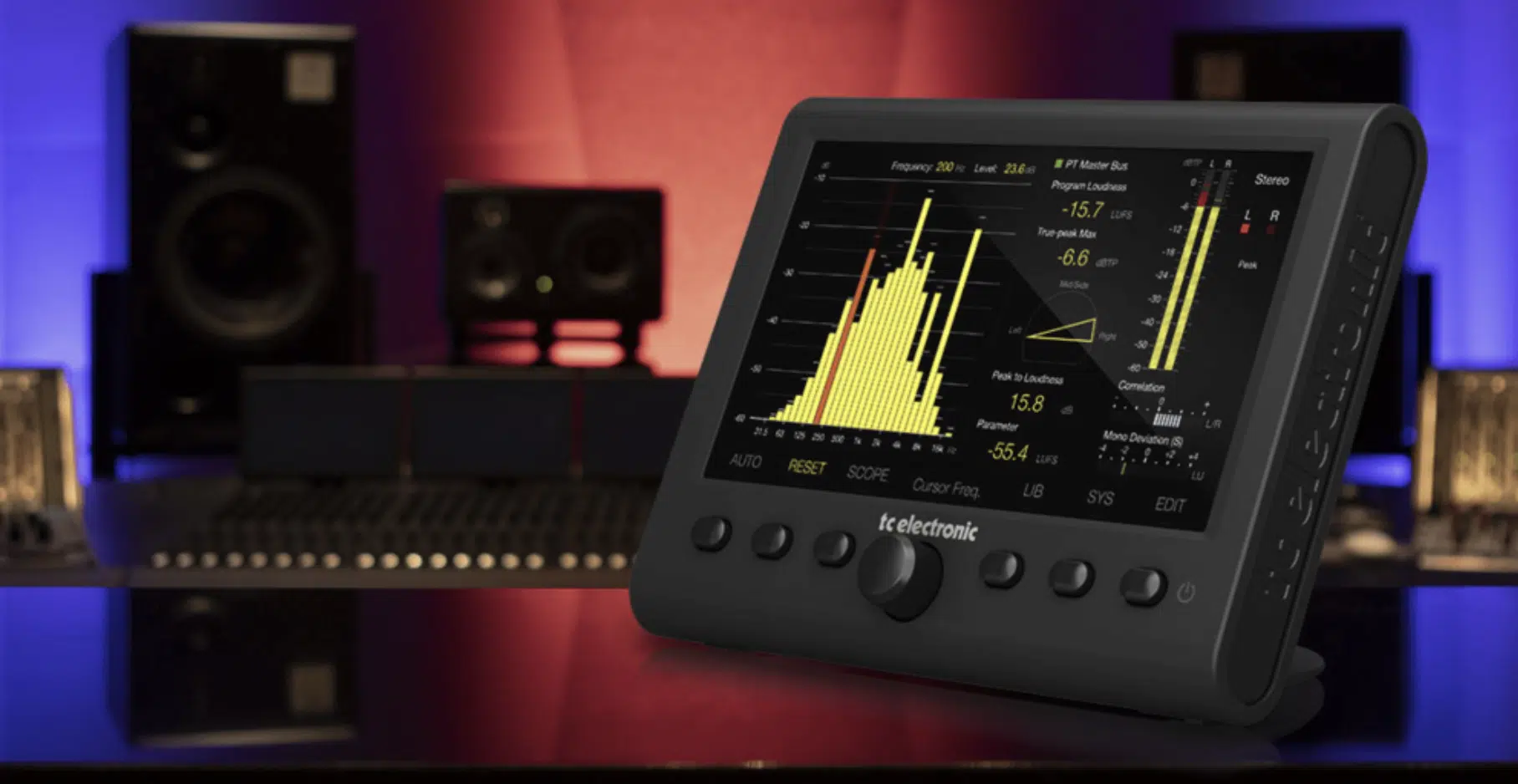
In the music production world, metering is super important because it allows you to measure loudness and ensure that your tracks sound polished and professional.
When working on a mix, you need to understand how different metering systems work to achieve the desired loudness without compromising the quality of your audio.
Whether you’re mixing for streaming platforms like Apple Music or mastering for radio stations, accurate loudness measurement makes sure that your track maintains consistency across various playback systems.
Remember, it’s all about consistency.
Understanding the differences between LUFS vs RMS and True PEAK metering helps you manage audio levels effectively.
Especially when it comes to avoiding inter-sample peaks and maintaining a solid dynamic range.
By mastering these concepts, your tracks will always translate well, whether they’re played on streaming services or through club speakers.
Don’t worry, we’ll be breaking down everything you need to know about LUFS vs RMS vs PEAK, so your tracks are always up to par.
LUFS vs RMS vs PEAK: Breaking it Down
Now that you know why metering is so important in your music production process, let’s break down the specific types (LUFS vs RMS vs PEAK) so you really get the full picture.
-
What are LUFS?
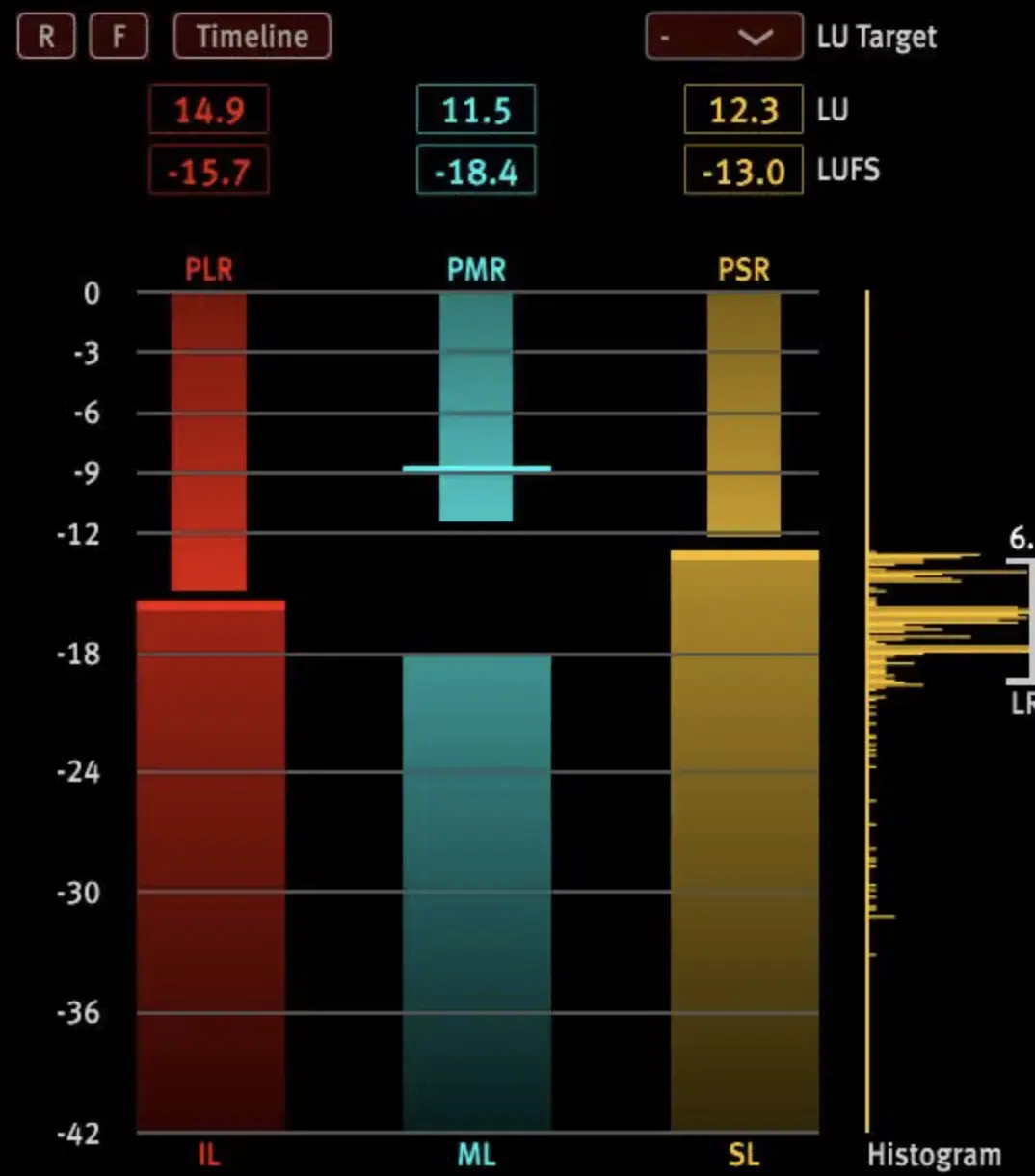
LUFS (Loudness Units relative to Full Scale) is a modern loudness measurement standard used to measure loudness in a way that aligns more closely with human perception.
Hence the term ‘perceived loudness,’ which I’m sure you hear all the time.
Unlike traditional Peak level measurements, LUFS focuses on the average loudness of a track over time, which is why it’s essential for streaming platforms like Apple Music.
LUFS values are key when mastering your music, as they help you avoid louder parts that might cause distortion and ensure your whole song remains consistent in volume.
LUFS metering takes into account the K weighting curve, which is designed to match human hearing sensitivity.
This makes it a more accurate reflection of how loudness is perceived.
Whether you’re dealing with short-term LUFS for individual sections or LUFS integrated loudness for the entire track, using a LUFS meter is vital for achieving the right balance in your audio signal.
Understanding how exactly to measure LUFS effectively, especially when aiming to meet the LUFS standard set by streaming services, is very important, so don’t overlook it.
NOTE: Remember, accurately hitting these targets can prevent your track from being turned down by streaming platforms, which could diminish its impact compared to other tracks in a playlist, which you definitely don’t want.
-
Understanding RMS (Root Mean Square)
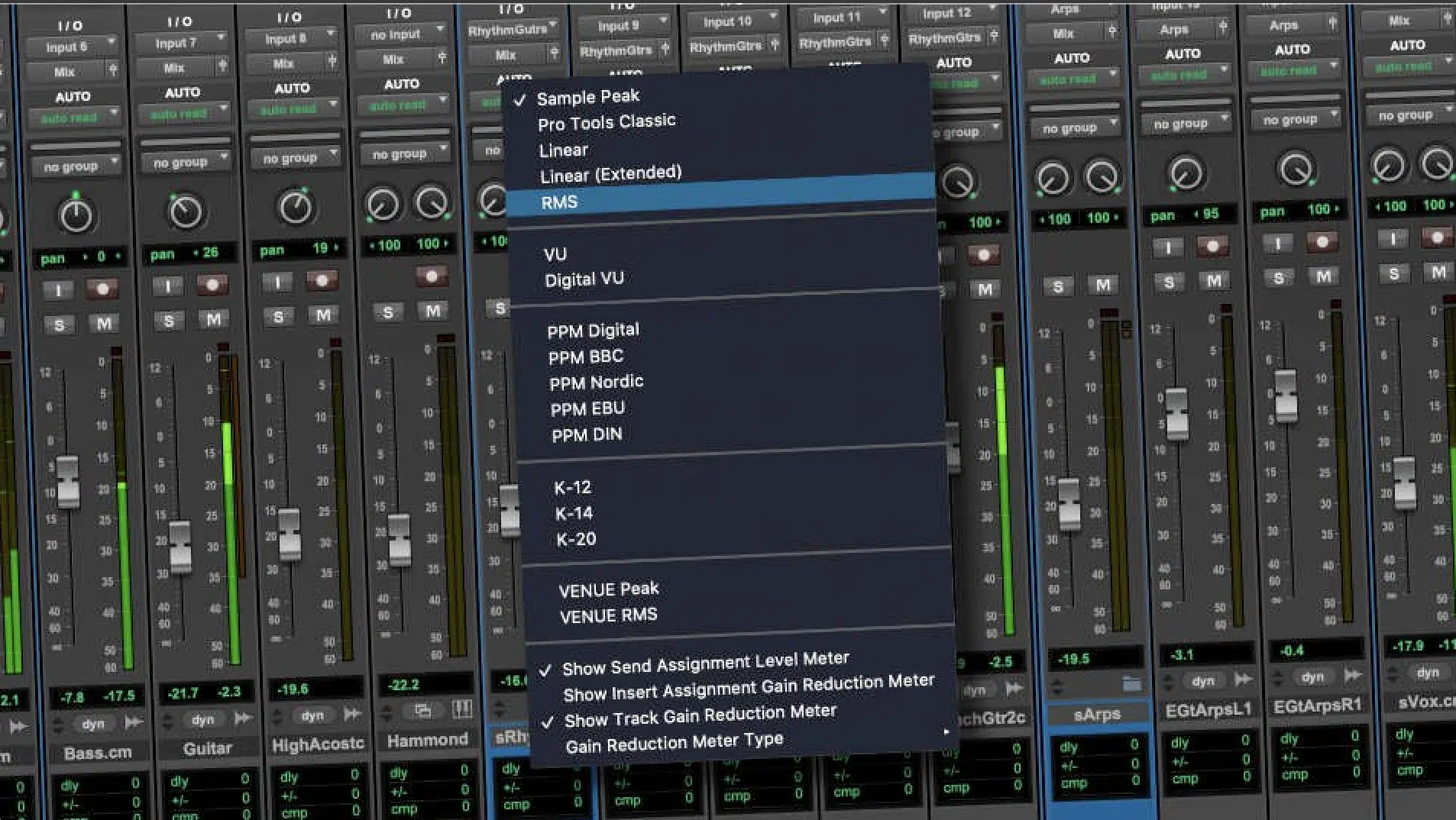
RMS (Root Mean Square) measures the average loudness or power of an audio signal over time 一 providing insights into the overall energy of a track.
Unlike Peak metering, which captures the highest points in a waveform, RMS measurement focuses on the consistent loudness level throughout the track.
This makes RMS metering super valuable when you want to ensure that your mix has a balanced loudness range (avoiding drastic fluctuations that could distract listeners).
An RMS meter gives you a clearer picture of how loud your track will sound on average level, which is essential for maintaining dynamic range without over-compressing the audio.
For example, in genres like hip-hop, EDM, or pop, aiming for an RMS level between -12 dB and -8 dB can create a powerful sound while preserving clarity.
However, for tracks that require more dynamic shifts (like rock or cinematic music), a slightly lower RMS level around -14 dB might be more appropriate to maintain punch while allowing for impactful contrasts between sections.
RMS measurement also plays a key role in mastering, helping you achieve an average RMS that ensures your track is competitive without sacrificing the dynamic feel.
NOTE: You’ll notice, when it comes to LUFS vs RMS vs PEAK, it’s all about making sure your tracks are professional, polished, competitive, and maintain that dynamic feel.
By regularly checking your RMS meter during mixing and mastering, you can fine-tune your audio levels to achieve the desired RMS level.
This way, regardless of playback systems, your tracks will always sound on point.
-
Exploring True PEAK Metering
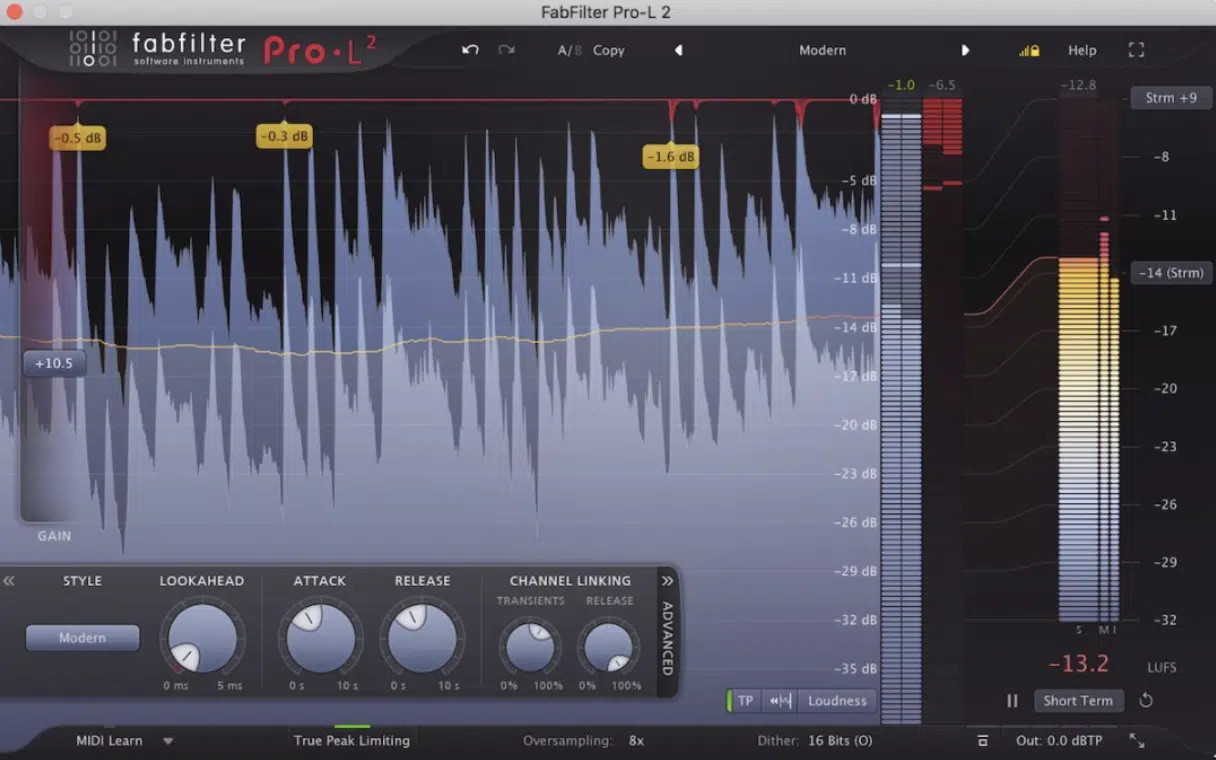
True PEAK metering is an advanced technique that goes beyond traditional Peak level metering by detecting inter-sample peaks.
If you’re unaware, inter-sample peaks are those elusive points that can occur between digital samples during conversion and playback.
They can cause unexpected distortion when your audio is converted to different formats, such as when uploading to streaming platforms like Apple Music.
True PEAK meters measure these potential peaks to ensure that the audio signal remains within safe limits (even after processing) so the quality is top-notch.
For example, when mastering for streaming services, True PEAK metering can help you avoid clipping, which could otherwise go unnoticed with regular Peak meters.
This metering is essential in today’s competitive world, where the loudness war has made it non-negotiable to achieve maximum level volume without sacrificing audio quality.
By employing True PEAK metering, you can safeguard your music from unwanted distortion, just like the other types.
Remember, the main difference between this type of metering and the others is it measures inter-sample peaks, which can occur between digital samples during playback.
Meaning, your audio remains clean and distortion-free even after digital-to-analog conversion (which is super beneficial).
LUFS vs RMS vs PEAK: Key Differences
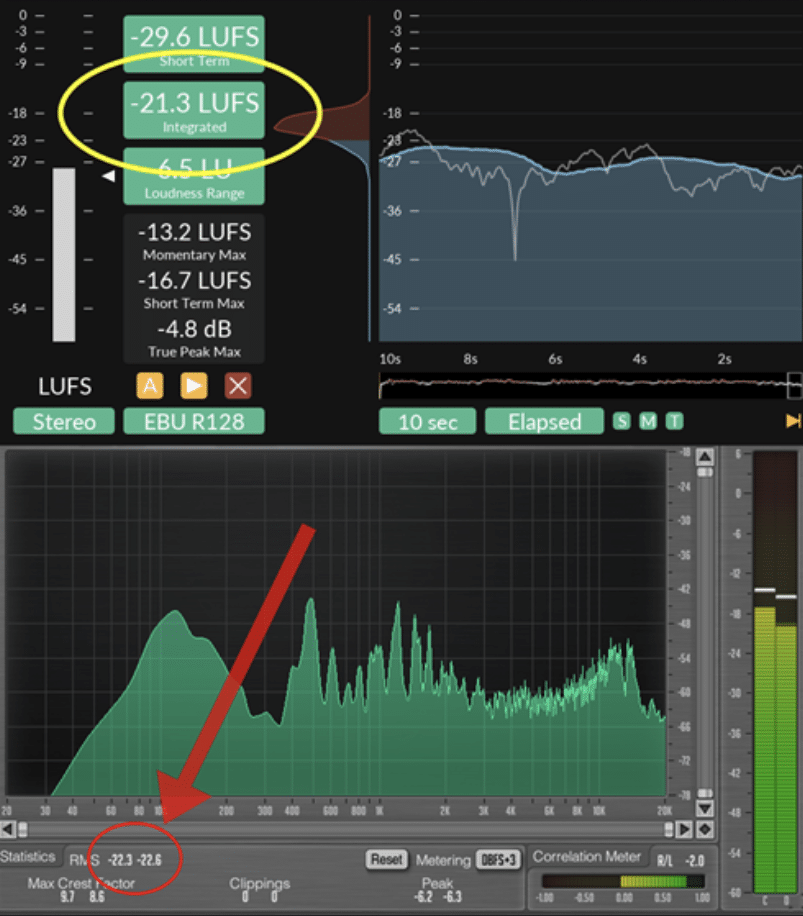
Understanding the key differences between LUFS vs RMS and True PEAK is essential for a well-balanced mix that sounds great across all playback systems.
Each metering system serves a unique purpose, and knowing when and how to use them can make all the difference in achieving the ideal loudness and audio quality.
Let’s break it down/sum it up…
LUFS (Loudness Units relative to Full Scale) is particularly focused on the integrated loudness of a track over time.
It provides a ‘LUFS level’ that reflects how loud a song will be perceived by the listener.
For example, many streaming platforms (Apple Music, Spotify, SoundCloud, etc.) target an integrated loudness of around -14 LUFS, which balances the need for clarity with the avoidance of unnecessary compression.
RMS, on the other hand, measures the average power of your audio signal, offering a snapshot of how much energy is present in the music over a specified period.
A typical RMS value might range from -18 to -12 dBFS depending on the genre and desired dynamic range.
For example, in electronic music genres, you might aim for a higher RMS to ensure the track feels powerful and full, captivating your audience instantly.
True PEAK metering is designed to detect inter-sample peaks, which can exceed the Full Scale (0 dBFS) during digital-to-analog conversion.
Yes, even if your Peak level reads below 0 dBFS.
A True PEAK meter helps you ensure that these peaks stay below the -1 dBTP (decibels True Peak) threshold recommended by many streaming services to prevent distortion.
By understanding and taking advantage of each of these meters (LUFS vs RMS vs PEAK), you can create a mix that meets industry standards and is instantly deemed ‘professional.’
I mean, you don’t want to sound like an amateur, am I right?
Tips & Techniques for Expert Metering
Having precise control over loudness in your mix requires not just monitoring your meters but also applying specific, advanced techniques that can significantly improve your results. So, let’s finish things off with 5 expert tips and tricks to help you master LUFS vs RMS vs PEAK (and how to use each like a boss).
#1. Use Short-Term LUFS Metering for Key Sections
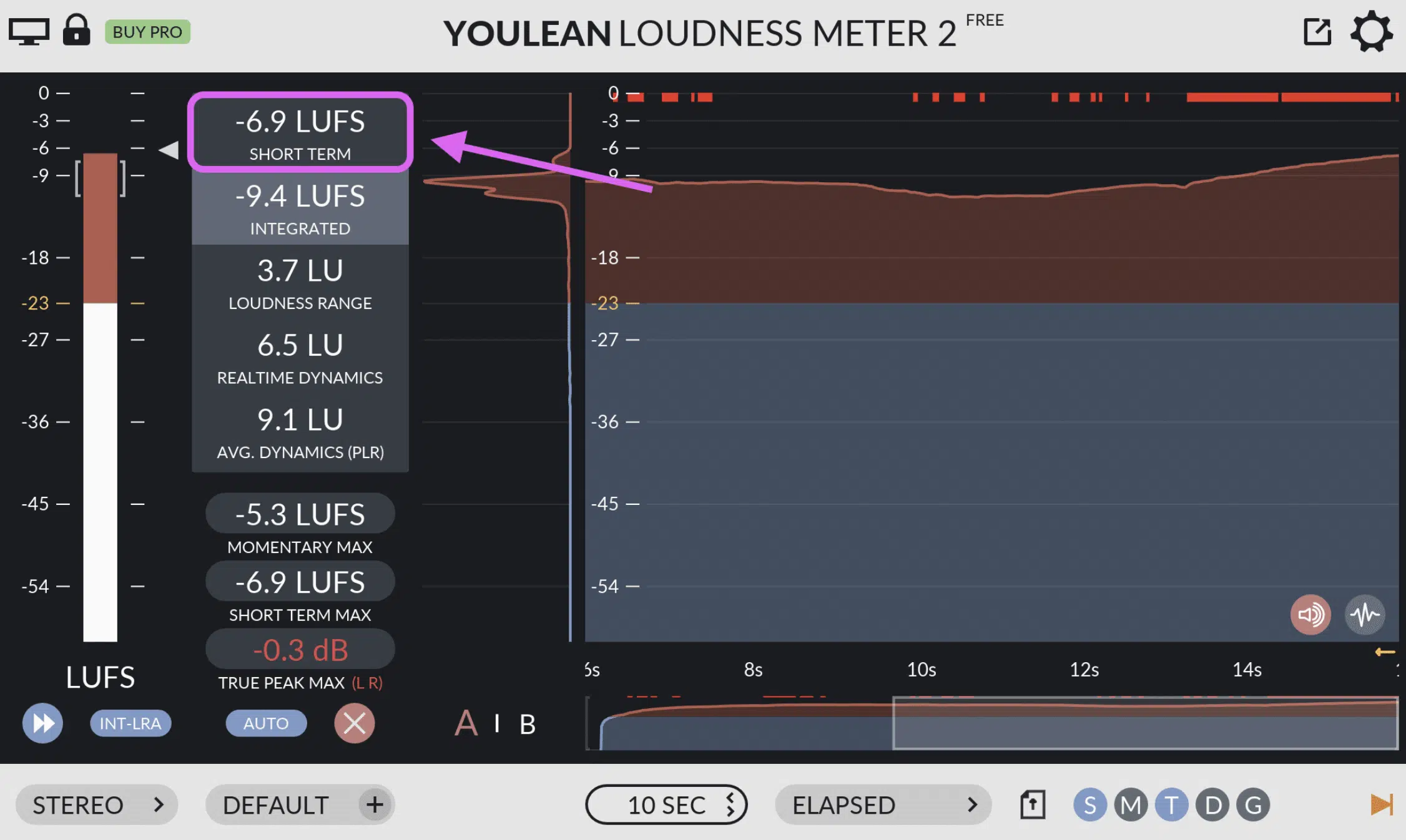
While integrated LUFS provides an overview of the loudness across the entire track, focusing on short-term LUFS during critical sections (like the chorus or the drop) can help you maintain consistent loudness where it matters most.
Short-term LUFS (Loudness Units relative to Full Scale) measures the loudness over a three-second window 一 giving you a real-time indication of how loud specific parts of your track are compared to the rest.
By ensuring that your short-term LUFS remains stable and aligned with your target loudness level during these sections, you can avoid sudden jumps or drops in volume that could distract listeners. Nobody wants that.
#2. Monitor in Mono to Catch Phase Issues and Peaks

Monitoring your mix in mono, rather than stereo, can reveal inter-sample peaks and phase issues that might not be obvious when listening in stereo.
Mono monitoring forces all your audio elements into a single channel, which can show problems with how your frequencies interact.
For example, instruments that sound clear in stereo might become muddled or have phase cancellation in mono.
Also, keep in mind that inter-sample peaks are more likely to cause distortion when played back on mono systems, such as smartphones or club PA systems.
So, regularly switching to mono while mixing and measuring your True PEAK levels in this mode will help everything be on point.
#3. Utilize Dynamic Range Meters for Balance
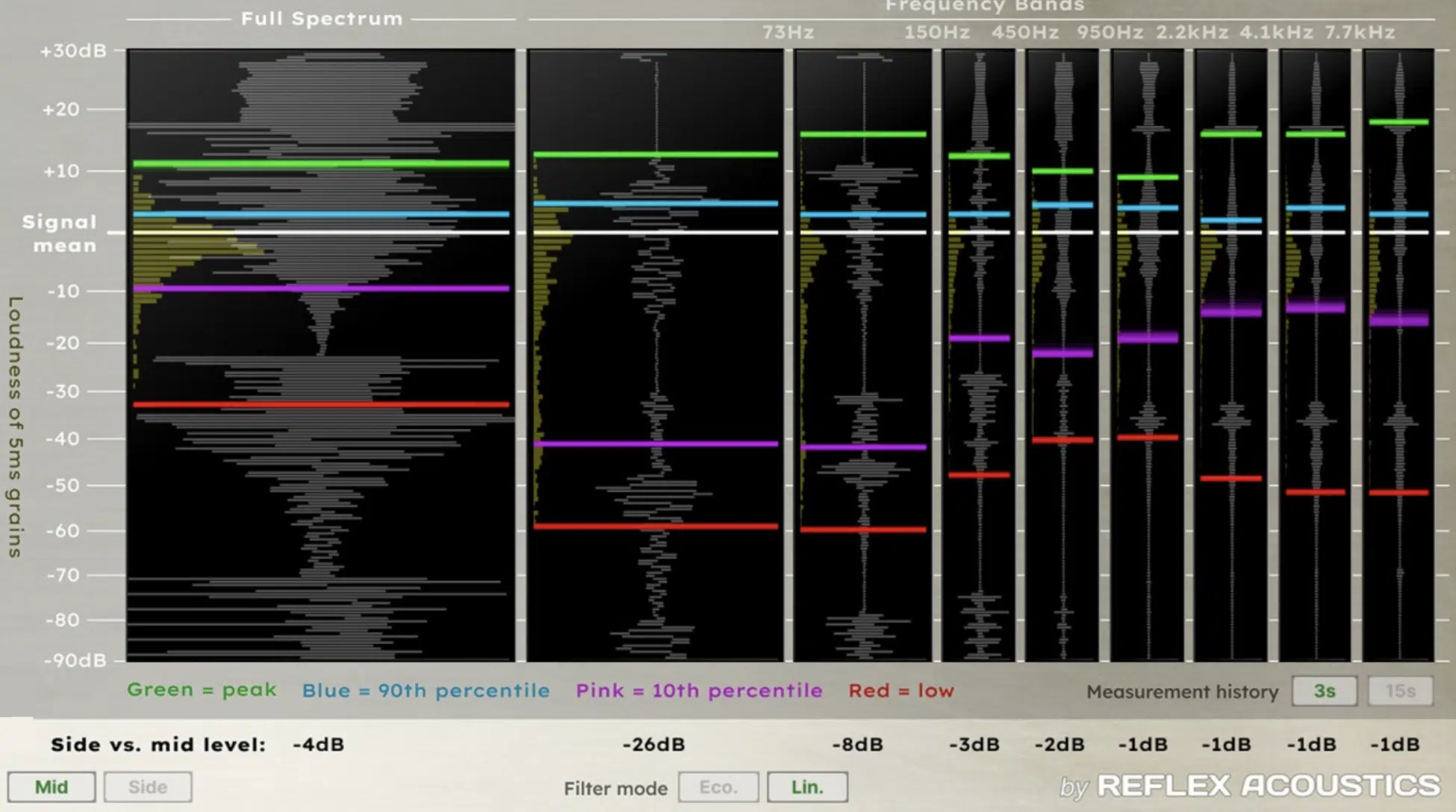
Dynamic range meters provide a visual representation of the range between the quietest and loudest parts of your track, helping you understand how compressed or expansive your mix is.
A good dynamic range maintains energy and excitement in your music without flattening out the nuances that give it character.
For example, let’s say you’re knocking out a rock or hip-hop beat… A more controlled range might be desirable to keep the energy consistent.
By using dynamic range meters alongside RMS and LUFS meters, your track will retain its intended impact without sounding overly compressed or squashed.
#4. Incorporate K-Weighting for Human Ear Sensitivity
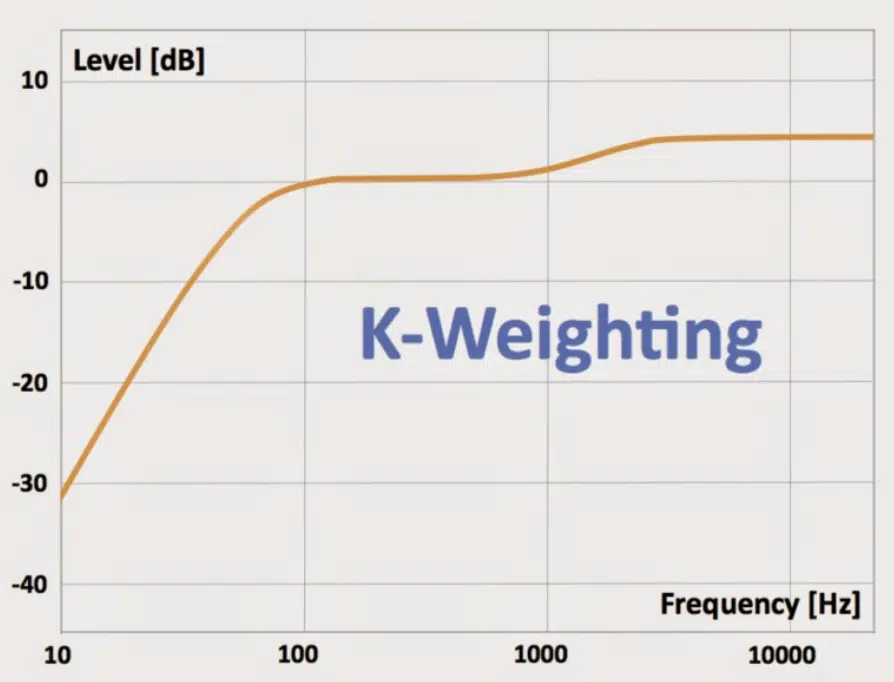
K-weighting is a specific filtering curve used in LUFS metering that adjusts the measurement of loudness to better match the sensitivity of the human ear.
The human ear is more sensitive to midrange frequencies (around 2-5 kHz) and less sensitive to very low or very high frequencies.
K-weighting applies a filter that de-emphasizes the low and high ends of the frequency spectrum.
It gives you a loudness measurement that more accurately reflects how a listener will perceive the volume.
When you’re mastering individual tracks for streaming platforms like Spotify or Apple Music, where perceived loudness units need to be balanced across diverse listening environments, it’s key.
Basically, by incorporating K-weighting into your LUFS metering, you can make sure that your track sounds consistent/natural to the listener, regardless of playback device.
#5. Take Breaks and Revisit Your Mix with Fresh Ears

Human perception of loudness and audio levels can change with fatigue, which is why it’s essential to take regular breaks and revisit your mix with fresh ears, especially when learning about LUFS vs RMS vs PEAK.
After long sessions, your ability to judge perceived loudness accurately diminishes, and you might end up over-compensating by boosting volume levels like a noob.
By stepping away from your mix for a short time and coming back with a refreshed perspective, you can catch any loudness inconsistencies or issues that you might have overlooked.
Take a 10-15 minute break every hour and do a final listening session at a lower volume level to ensure that your track sounds balanced and cohesive across the board.
And don’t believe anyone who says ear fatigue isn’t a thing… I can’t emphasize this enough.
RMS and LUFS and PEAK: Final Thoughts
Mastering the differences between LUFS vs RMS vs True PEAK is essential if you’re looking to create tracks that are not only loud but also clear, dynamic, and polished.
Understanding how each metering system contributes to your overall sound can make the difference between a track that resonates with listeners and one that falls flat.
By utilizing LUFS vs RMS vs True PEAK metering correctly with the tips from this article, your music will always stand out on streaming platforms without sacrificing any audio quality.
To really get a better understanding of this topic (and take your skills to the next level), you’ve got to download these legendary Free Beatmaker Templates.
They’re packed with meticulous templates for Ableton, FL Studio, and Logic Pro, all mixed/mastered to perfection by top producers and sound designers.
Analyzing these templates with any quality metering plugin will provide a masterclass in how LUFS and dynamic range work in real-world, professionally crafted tracks.
It’s like having a pro audio engineer sharing their secret sauce with you.
With this knowledge, you’ll be able to produce tracks that not only meet industry standards but also captivate your audience.
So, dive into your next project with confidence, knowing that your understanding of LUFS vs RMS vs True PEAK will guide you to create polished music every single time.
And never stop experimenting, learning, and growing 一 it’s the key to a long-lasting career in the production world.
Until next time…







Leave a Reply
You must belogged in to post a comment.